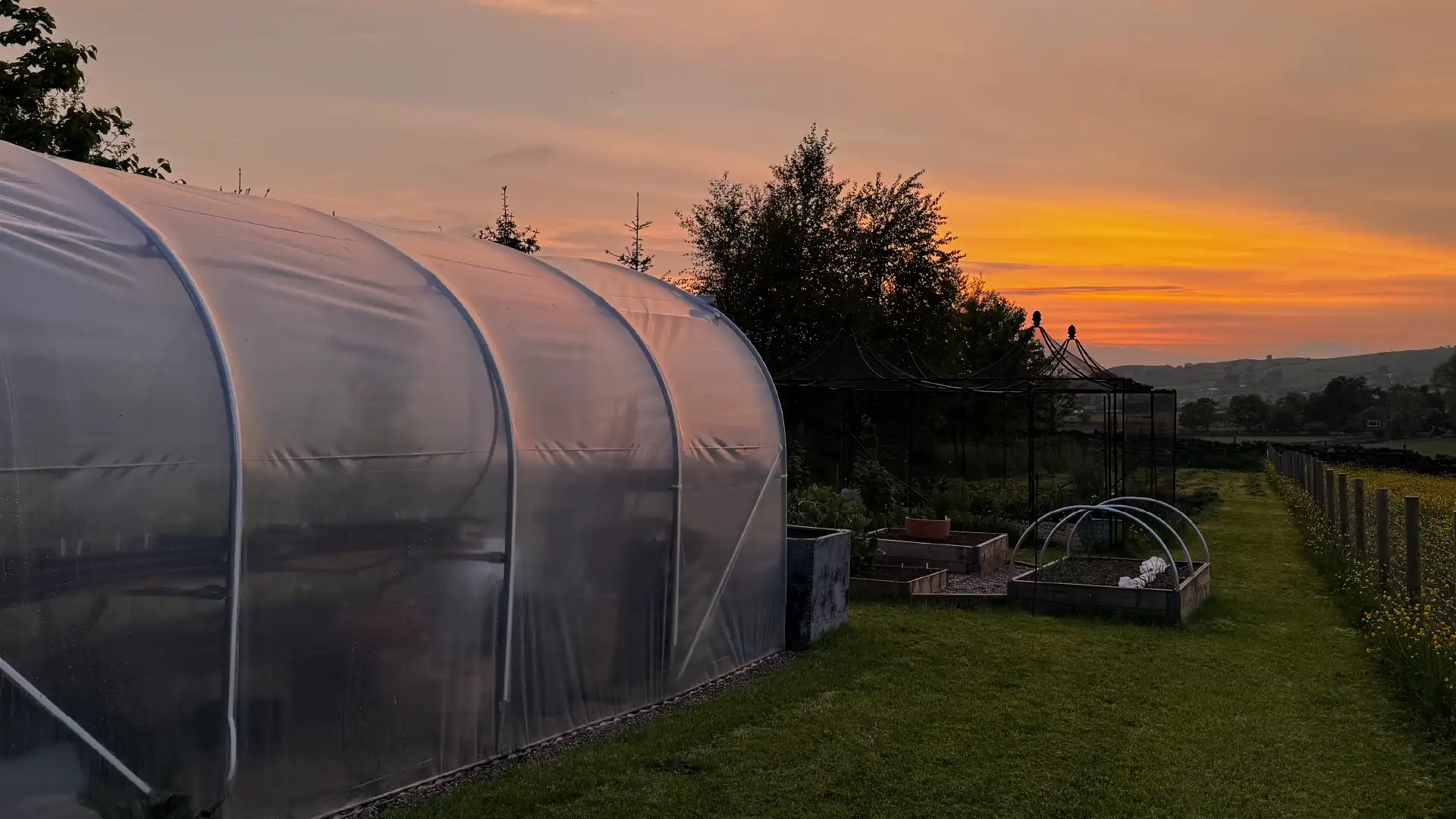Extending the life of your polytunnel
You’ve likely spent a fair amount of your polytunnel, and in your mind it is a lifelong investment that with the cost of it spread over many, many years will end up a worthwhile investment; and then the reality of those winter winds, torrential downpours hit home and you wonder how you can proverbially wrap your polytunnel up in cotton wool. In this blog, we have the answers for you.
How long should your polytunnel last?
The lifespan of a polytunnel typically ranges from 5 to 20 years, depending on factors such as materials used, maintenance, and the local climate you find yourself in. Higher-quality materials and proper care can take your polytunnel closer to the 20 year life expectancy, but neglect can reduce its life to just a few short years.
At NP Structures, we utilise the very best quality materials and use cutting edge manufacturing techniques to ensure we produce the best possible product that’s built to last.
With some basic maintenance you can expect to get an extremely long life from your polytunnel framework, periodic cover changes may be required, but the security of your structure should ensure you decades of enjoyment.
How can you extend the life of your polytunnel?
Here are our four top tips for extending the life of your polytunnel:
Choose Quality Materials:
Look for a good quality UK manufactured framework, suitable for the British climate. No one wants to invest in a greenhouse, then spend time carefully growing and cultivating fruits and vegetables only to find their structure was poorly manufactured and has blown away in strong winds.
At Northern Polytunnels we test the suitability of our polytunnels to ensure that they can handle anything the British weather can throw at them through extensive wind and snow load testing. Our design team works tirelessly to design the strongest polytunnels possible.
The polythene you use to clad your polytunnel is an equally important decision, poor quality polythene will need to be replaced often but can also impact the taste and look of your fruit and vegetables. Look out for the thickness of your polythene, very thin films will rip and tear easily, we’d recommend 720g (180 micron). UV Open film is a must if you are hoping to grow plants or flowers under the film, without the full UV spectrum plant life will struggle to reach its full potential.
Proper Installation:
Good quality foundations are a must, a strong foundation is the basis for a sturdy polytunnel. Ensure you follow the manufacturers guidelines around how to install foundations properly – guidance will vary between manufacturers.
Different types of foundations are available, often the most suitable foundation will be dictated by your soil type or the kind of ground you are trying to seat your polytunnel on.
Regular Maintenance:
At Northern Polytunnels we recommend you conduct regular checks on the health of your polytunnel and act quickly to repair any damage.
Regular cleaning of the polythene is advised, over time green algae will build up on the film and reduce the amount of light getting into the polytunnel. This process will happen more frequently if your polytunnel is sited under trees or foliage.
Ensure you use a suitable product, household cleaners can damage important coatings on the polythene, we would recommend a specialist cleaner such as Polytex Pro.
Seasonal Adjustments:
Remove snow accumulation in winter and adjust ventilation during hot months to prevent overheating.
In the event of heavy snowfall, ensure you remove any large blocks of snow that have settled onto the polythene with a soft brush. Snow can be very heavy and cause sagging and even collapse of the cover when left unmanaged.
Hot summer months should also be considered during the construction of your polytunnel, anti-hotspot tape should be applied to any of the metal framework that will come into contact with your cover. During extremely hot weather the metal framework can scorch the cover creating damaging hotspots.
At Northern Polytunnels, all our polytunnels are supplied as standard with anti-hotspot tape. Do check that the structure you are interested in includes this as standard – many polytunnels on the market do not.
5 Tips for Maintaining Your Polytunnel
Here are our top five tips for maintaining your polytunnel, so that you can keep it at its optimum for longer.
Ventilation: Ensure proper airflow to prevent overheating and humidity buildup.
Excessively high temperatures and humidity is not the best environment for optimum plant growth. High temperatures will likely cause plants to wilt. Excess humidity levels will culture and spread disease amongst your plants.
Ensure airflow by cladding doors in netting during summer or leaving them open during the day. Side ventilation panels also ensure the flow of air through the polytunnel. Easy to install ventilation kits can be retrofitted onto your polytunnel. Roof ventilation is also available for domestic polytunnels.
Monitor Humidity and Temperature: Use thermometers and hygrometers to keep track of conditions inside the tunnel.
Smart technology can allow you to monitor the conditions in your polytunnel from your phone, however a basic thermometer is also useful to gauge the minimum and maximum temperatures in your polytunnel.
Inspect for Damage: Regularly check for holes, tears, or signs of wear in the plastic and frame.
Any minor damage to the polythene can be repaired using polythene repair tape. Replace any damaged or corroded parts of the bracketry or framework – any damage will compromise the integrity of your structure.
Pest Control: Implement integrated pest management practices to reduce the risk of infestations.
Measures should be taken to manage the build-up of flies and bugs in the polytunnel. Too many could encourage birds to peck at the polythene cover and cause damage when trying to reach the flies.
Other predatory bugs and pests should also be carefully managed to ensure minimum crop damage. Should there be signs of infestation, consider the application of beneficial nematodes to harness the power of nature and use biological pest control before turning to chemical-based approaches.
Cleanliness: Keep the area around and inside the polytunnel tidy to prevent disease and pest problems.
Damage can easily be caused to your polytunnel during bad weather by garden furniture or tools that have not been secured. Flying debris can quickly damage and tear the polythene sheet.
How to Get More Value from Your Polytunnel
When you’ve spent all of that money on a polytunnel, you want to maximise the crop value and enjoyment value that you get from it, here are our top tips.
Diverse Planting: Grow a variety of crops year-round, utilising companion planting techniques. Try to grow exotic fruit & vegetables that are expensive to buy but also come with a hefty carbon footprint in the supermarket.
Items like peppers, melons & tomatoes are often imported from far flung locations. Save on excessive travel mileage by trying to grow as much of this as possible yourself.
Early Start: Use it to start seeds early in the season or extend the growing season into the autumn.
Strawberries can be overwintered inside the polytunnel, early varieties can start to ripen as early as May, ensuring you have delicious fruit when the supermarket is stocking out of season produce grown in hotter climates. These can often lack the delicious taste of British grown strawberries.
Succession Planting: Maximise space and yield by planting crops in succession as soon as one is harvested.
This can require some organisation, but is a really fantastic way of ensuring you have a continuous crop throughout the season and avoiding plants going to seed or turning woody or bitter.
Experiment with Techniques: Try hydroponics, vertical gardening, or raised beds to optimise space and productivity.
Gardening can be a really great way to experiment and grow things that are difficult to get hold of in supermarkets. We’d recommend experimenting with microgreens, vertically planting fruits and berries or concentrating on unusual heritage varieties of fruit and veg. With supermarkets stocking out of season items all year round, choice as a consumer is plentiful. However, unusual varieties are seldom stocked, get the satisfaction from your polytunnel by growing things that you can’t get hold of easily.
Can You Resell Your Polytunnel?
If your polytunnel is in good condition, then you may be able to resell it in the future and recoup some of the initial investment that you made in buying it.
Make sure to clean it thoroughly and provide any original documentation.
To maximise the resale value of your polytunnel, we would recommend highlighting its features, such as size, material quality, and any included accessories, to attract potential buyers.
Online marketplaces, local gardening groups, or classified ads can be effective for resale.
Look after your polytunnel and it’ll look after you.






